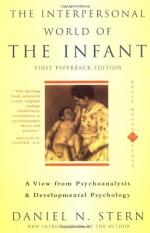
|
| Name: _________________________ | Period: ___________________ |
This test consists of 5 multiple choice questions, 5 short answer questions, and 10 short essay questions.
Multiple Choice Questions
1. The subjective self is the part of development which occurs when an infant finds they have a ________ and that others do as well.
(a) Name.
(b) Purpose.
(c) Head.
(d) Mind.
2. Clinical and parental view tend to converge in believing the child has an active subjective life including ______.
(a) Lack of participation in the environment.
(b) Changing objective experiences.
(c) Changing vision.
(d) Changing emotions.
3. According to the book new _______ has opened doors for acquiring new information and generating new theories.
(a) Research.
(b) Species.
(c) Social orders.
(d) Psychologies.
4. According to the book, recent research indicates that the infant is capable of having a sense of self and ______.
(a) Emotions.
(b) Thoughts.
(c) Body.
(d) Others.
5. According to the book, there are several senses associated with the self, some found ______, others are not.
(a) In a valley.
(b) Outside of the body.
(c) Outside of awareness.
(d) Inside the body.
Short Answer Questions
1. Infants in the emergent self stage have a disposition to create and test ______ about the world.
2. The observed infant consists of the ________ that the infant demonstrates while under observation.
3. The first sense of a self created in the first 8 weeks will remain active for _______.
4. From birth to two months of age, the _____ is employed to relate diverse experiences, affects, perceptions and events.
5. Stern believes that the _______ is the primary organizing principle of development.
Short Essay Questions
1. What happens to infants when they are between the second and third months of life?
2. What does intersubjective relatedness involve deliberately in the study of infants, according to the content of the book?
3. How does psychoanalysis define progressive reorganizations of infant psychology, according to the content of the book?
4. What does infant research note about the capability of the infant who is between two and three months?
5. What happens when an infant gains a sense of core self for herself and for others?
6. What are the differences between the observed infant and the clinical infant in terms of social interaction?
7. What happens as a result of infants having a central disposition to create and test the hypotheses of the world?
8. What have a number of revolutions in collecting information done for the study of infants?
9. How do the experiences of being with another become active acts of integration, according to the content of the book?
10. What is the problem with reactivity, according to this section of the book, in relation to an infant's story?
|
This section contains 642 words (approx. 3 pages at 300 words per page) |

|




